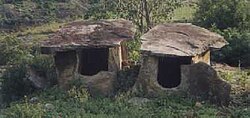Dolmen
A dolmen is a type of single-chamber megalithic tomb.[1] It usually consists of three or more upright stones (megaliths) supporting a large flat horizontal capstone (table).
Most date from the early Neolithic period (4000 BC to 3000 BC). Dolmens were usually covered with earth or smaller stones to form a barrow, though in many cases that covering has weathered away, leaving only the stone "skeleton" of the burial mound intact.
Dolmen Media
Poulnabrone dolmen, the Burren, County Clare, Ireland
Dolmens in Amadalavalasa, Andhra Pradesh, India
Dolmen at Ganghwa Island, South Korea
Trethevy Quoit – one of the best-preserved in Cornwall, UK dated to around 3500–2500 BCE
Chûn Quoit in Cornwall, UK, about 2400 BCE
Lanyon Quoit in Cornwall, UK, 3500–2500 BCE
Dolmens of Marayoor, India.
A southern-style dolmen at Ganghwa Island, South Korea
The biggest dolmen near Hwasun, South Korea
Notes
- ↑ Also known as 'cromlech', 'quoit', or 'portal tomb'









